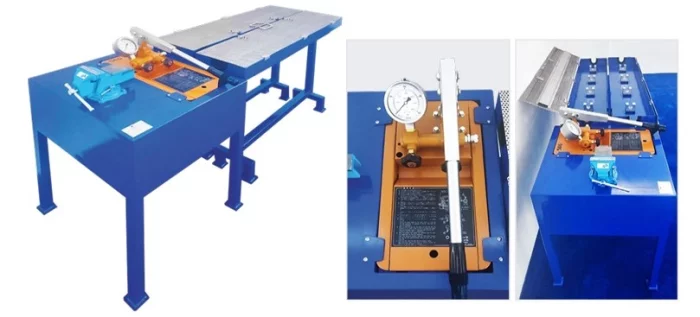Hydro Static Test Machine
Hydrostatic Test Machine is designed and manufactured for the technical needs of testing over pressure hose assemblies.
Description
More Products & Services
Products & Services
Hydraulic Test Bench - Multi function Airbus A330, A320, Boeing B737-800 & ATR72
PT Pudak Scientific
Key Functions of an Aircraft Hydraulic Test Bench
System Pressure Testing: Tests the hydraulic system at different pressure levels, mimicking the conditions experienced during flight. This helps verify that seals, valves, and pumps can withstand the pressures without leaks or failures.
Flow Rate Testing: Assesses the hydraulic system's ability to maintain proper flow rates, which is essential for the timely operation of systems like landing gear and flight controls.
Leak Detection: Checks for any leaks or pressure drops that might indicate a damaged or worn component.
Temperature Management: Since hydraulic systems can heat up during operation, the test bench can simulate different temperature conditions to ensure the system operates reliably under both high and low temperatures.
Functional Testing of Components: Allows for the testing of individual components, such as actuators, pumps, and valves, to ensure they meet performance standards.
System Pressure Testing: Tests the hydraulic system at different pressure levels, mimicking the conditions experienced during flight. This helps verify that seals, valves, and pumps can withstand the pressures without leaks or failures.
Flow Rate Testing: Assesses the hydraulic system's ability to maintain proper flow rates, which is essential for the timely operation of systems like landing gear and flight controls.
Leak Detection: Checks for any leaks or pressure drops that might indicate a damaged or worn component.
Temperature Management: Since hydraulic systems can heat up during operation, the test bench can simulate different temperature conditions to ensure the system operates reliably under both high and low temperatures.
Functional Testing of Components: Allows for the testing of individual components, such as actuators, pumps, and valves, to ensure they meet performance standards.
Oxygen Regulator Test Bench
PT Pudak Scientific
An oxygen regulator test bench is a critical tool for ensuring the safety and reliability of oxygen systems in aircraft. It verifies that the regulators function properly under various conditions and ensures they meet strict regulatory standards, which is essential for the safety of both crew and passengers at high altitudes.
Smoke Detector Test Bench
PT Pudak Scientific
A smoke detector test bench for aircraft is a specialized setup designed to test, calibrate, and ensure the reliability of smoke detection systems installed in aircraft cabins, cargo holds, lavatories, and other compartments. Here’s an overview of the essential components and considerations for such a test bench:
- System overview
- Core components of the test bench
- Testing procedures
- Safety and compliance
- System overview
- Core components of the test bench
- Testing procedures
- Safety and compliance
Oxygen Safety Chamber
PT Pudak Scientific
GENERAL INFORMATION
Oxygen Safety Chamber Technical Data
P/N : P/N:145D-950-35-ATD0035
S/N : -
Media : Air
Maximum Operating Pressure : 2250 Psi
Surrounding temperature : 0 - 40 °C
Weight Range Description : 230 kg
The Oxygen Safety Chamber is used as a connection to an air storage system and/or a compressor to refill an oxygen cylinder. The filling station is designed to offer protection to the operator against the impact of explosive forces in the event of a cylinder failure during filling, while at the same time storing the resulting debris.
The main components of the piping system are: Pressure gauge, Needle valve, Relief valve, Open/close valve air operated,
Regulator, Mechanical limit switch, Connector.
Oxygen Safety Chamber Technical Data
P/N : P/N:145D-950-35-ATD0035
S/N : -
Media : Air
Maximum Operating Pressure : 2250 Psi
Surrounding temperature : 0 - 40 °C
Weight Range Description : 230 kg
The Oxygen Safety Chamber is used as a connection to an air storage system and/or a compressor to refill an oxygen cylinder. The filling station is designed to offer protection to the operator against the impact of explosive forces in the event of a cylinder failure during filling, while at the same time storing the resulting debris.
The main components of the piping system are: Pressure gauge, Needle valve, Relief valve, Open/close valve air operated,
Regulator, Mechanical limit switch, Connector.
STATIC ENGINE STAND ATR72 AIRCRAFT (PW127M)
PT Pudak Scientific
Data Teknis Engine Stand ATR72 – PW127M (Weight 482 Kg)
P/N : 1001040-1
S/N : -
Media : -
Tekanan Operasi Maksimal : -
Temperature sekeliling : 0 - 40 °C
Kisaran Berat Deskripsi : 200 kg
This static engine stand is useful for supporting the PW127m engine, when off wing.
May only be used for storage, not for transport or delivery.
Cannot be moved if the engine is still installed
P/N : 1001040-1
S/N : -
Media : -
Tekanan Operasi Maksimal : -
Temperature sekeliling : 0 - 40 °C
Kisaran Berat Deskripsi : 200 kg
This static engine stand is useful for supporting the PW127m engine, when off wing.
May only be used for storage, not for transport or delivery.
Cannot be moved if the engine is still installed
SCISSOR AIRCRAFT LIFT SEAT
PT Pudak Scientific
Aircraft Scissor Lift Seat: (Multi function A330, A320 & B737)
P/N : MS4000011-1
S/N : TE11247812
Max Capacity / Payload : 1200 Kg
Seat Information : Seat dimension (P62.2 inch | L26.28 inch) ; Weight 110.2 Lbs.
Height : Min 800 mm | Max 6000 mm
Loading & Unloading : 14 row seats
P/N : MS4000011-1
S/N : TE11247812
Max Capacity / Payload : 1200 Kg
Seat Information : Seat dimension (P62.2 inch | L26.28 inch) ; Weight 110.2 Lbs.
Height : Min 800 mm | Max 6000 mm
Loading & Unloading : 14 row seats
People
Description
This Hydrostatic Test Machine system uses a manual hand-pump with high pressure water media.
In operation, this tool can produce pressure of 6000 Psi.
In operation, this tool can produce pressure of 6000 Psi.

Share
Recent Chats
Share via email
Future: handle WhatsApp here
Future: handle LinkedIn here
Future: handle Twitter here
SUBMENU HERE
Share via Chat
Copy Link





